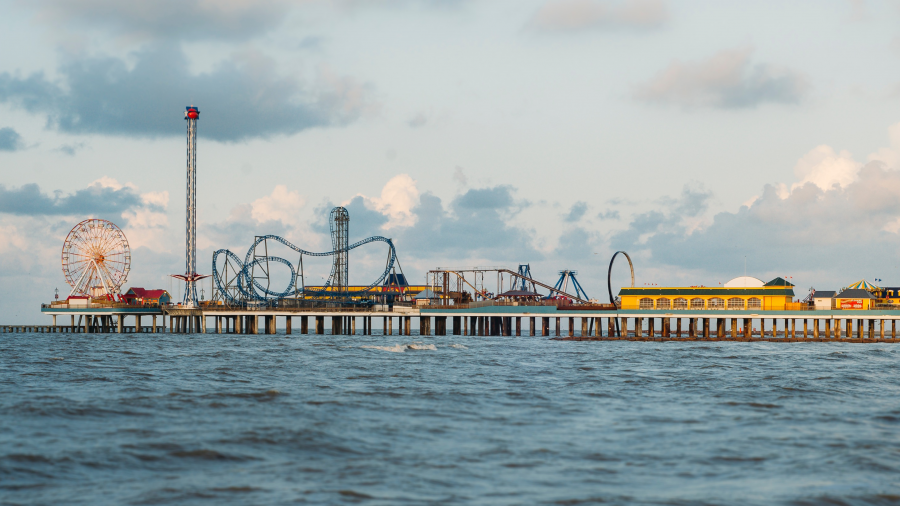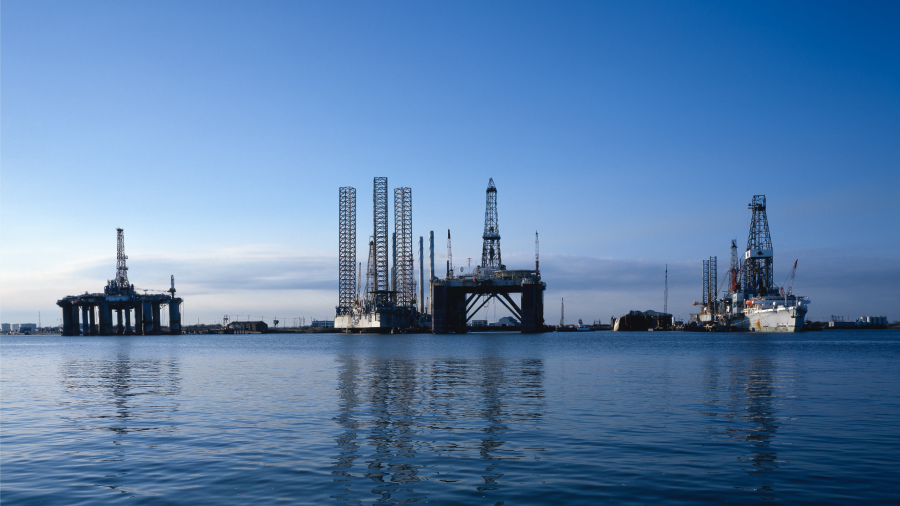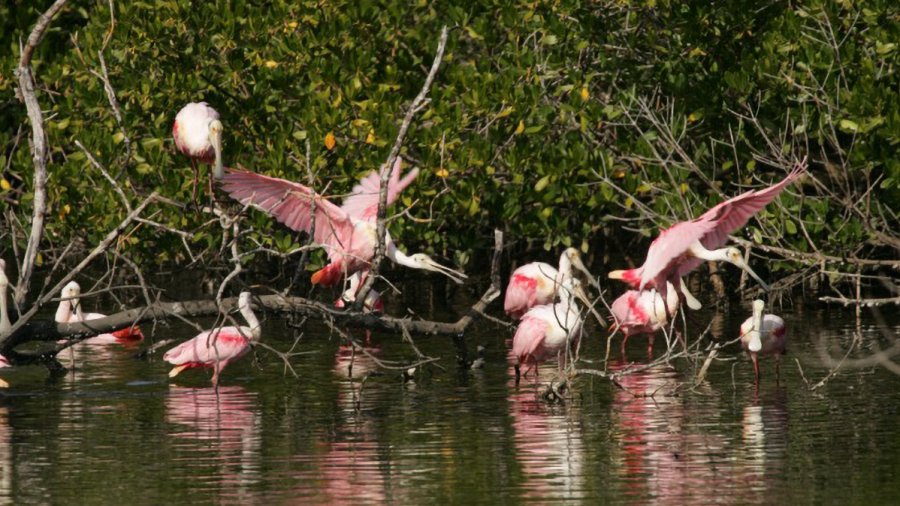
To view in your browser and/or download the lesson, click on the PDF below.
As climate change causes sea level rise (SLR) that continues to stress coastal communities across the world, community leaders, engineers, ecologists, and local residents must collaborate to find solutions that enhance the resilience of their shoreline from SLR and ever-stronger storms. Several competing strategies for resilience-building include hardscape seawalls and softscape biotic barriers such as mangrove forests. This lesson provides two contrasting case studies. First is Galveston, Texas, a large Gulf-Coast city with high poverty rates and extreme vulnerability to SLR, filled with hardscape and petrochemical infrastructure. Next is Sanibel Island, a Florida Gulf-Coast barrier island that has a history of natural preservation and remediation; it also has wealthy homeowners willing to invest in natural habitat restoration. Next, participants will learn about two resilience strategies—seawalls versus sea sponges—enabling them to suggest the best investment strategies to increase coastal resilience. Then, they will consider the environmental justice differentials between the sites and write a preliminary Grant Proposal Narrative for the National Oceanic and Atmospheric Administration’s (NOAA’s) Climate Ready Coasts grants program.
- Profile Gulf Coast cities with different demographics, infrastructure, and sea level vulnerabilities.
- Consider sacrifice zones, environmental justice, and histories of investment based on economic and sociological factors.
- Contrast hardscape and softscape remediation and resilience plans and their ecological and social effects.
- Build grant-writing skills by preparing a collaborative grant proposal focused on increasing coastal adaptation and resilience.

Photo by Carol Highsmith. Public domain via Wikimedia Commons.

Photo by Steve Hillebrand/U.S. Fish and Wildlife Service. Public domain via Wikimedia Commons.
View these two images of the American Gulf Coast in Texas and Florida. In a 5-minute lightning session, have learners quickly call out the contrasts in coastal infrastructure, aesthetics, and implied quality of life for the human and wildlife populations in each place. Then have them imagine what each coast might look like in 2100 if left alone, assuming a sea level rise of two feet (NOAA estimate).
Resilient and Restorative Grant Funding (Three 75-minute classes)
-
Class Session 1
If learners have not already done so, have them read the very short SESYNC Resilience Explainer.
Divide learners into two groups: Galveston, TX and Sanibel, FL. Have the groups pull up their locations on Google Maps to get an overview of the size of and infrastructure in each place. Then have them compare demographics from the U.S. Census Bureau. Ask sociological questions:
- What are some contrasts between the populations of these two Gulf Coast cities?
- Compare Age, Race, Income, Education, Poverty, and Population Density. Discuss sacrifice zones, especially in American petrochemical production regions.
- As a class, brainstorm the social challenges to building coastal resilience in each socio-environmental location. Though learners may accurately list hurdles that come from high-density development and external pressures like poverty (both related to environmental justice), they should also evaluate how wealth, privilege, and “not in my backyard” (NIMBY)-ism might affect plans for resilient infrastructure.
Next, have the Galveston group read existing plans and mandates in the following documents:
The Sanibel group reads up on natural resources and risks in the following:
- Sanibel Comprehensive Plan (p. 29-73)
- Sanibel, FL Coastal Risks.
On the risk maps, a “100-year flood” is an 8.6-ft. surge in Galveston, and a 3.2-ft. surge in Sanibel. Why the difference? What are the implications?
Each group makes detailed notes of the history of coastal resilience planning and how the future plans integrate hard infrastructure like seawalls vs. living resilience like mangrove forests and reef restoration. Galveston’s history is more the former; Sanibel’s is the latter. Is it coincidence or correlation that the more privileged location benefits from living resilient ecosystems and actively plans for their preservation? What local demographics and economics (such as tourism and the petrochemical industry) have influenced the differential state of these cities’ ecologies?
Have the groups finish this research and planning session by considering details of the NOAA Grants Program. They should review the Coastal Zone Management and Habitat Restoration programs and select their choice of grant. Note: The Habitat Restoration grants have a special provision for Underserved Communities. Each group should end with a target grant identified.
-
Class Session 2
In the next class, groups should plan a NOAA Grant Narrative (below, p. 3–5) that articulates a need for funding coastal restoration in line with the city planning documents.
DocumentLearners should aim to synthesize ecology with restorative justice in vulnerable communities. Note the specific Diversity and Inclusion priority on NOAA grants, which has clear applications to the Galveston, TX, grant. The Sanibel group can be creative about how to argue for a more inclusive and diverse future for the island, perhaps through urban education field trips, outdoor camps, and enrichment for Florida’s environmental justice groups who do not live on Sanibel.
Both grants should prefer biotic resilience strategies over hardscape seawalls and ephemeral “beach renourishment” regimes.
The NOAA Grant Narrative is limited to 15 pages, and learners should only complete the A, B, and D sections of the narrative so that their work will be shorter. Spend the 75-minute class in a collaborative writing exercise.
As homework, have each group finalize and upload their Grant Narrative to the course space. Groups should read the opposite grant before attending the next class.
-
Class Session 3
In the final class (optional), have each group present their Grant Narrative to a mock “NOAA review panel” in charge of awarding $2M in grant monies. The instructor might convene a 3-4 person panel including the instructor, colleagues, and graduate learners. The Galveston and Sanibel teams compete for this money though it may be divided between them, equally or unequally.
Each group has ~15 minutes to present background, present challenges, and future plans, and respond to questions from the panel. The panel should reward creative, vivid, and synthetic solutions, as well as planning that is ecologically sound and promotes greater equality.
The review panel consults with each other and develops a list of strengths and weaknesses of each proposal that would influence a funding decision.
Finish with a review and discussion of the proposal development and review process and what the students learned with respect to resilience planning, coastal challenges, environmental justice, and infrastructure choices.
-
Assessing the relationship between social vulnerability and community resilience to hazards
This article is useful background because it stresses the important role that social factors play in determining community resilience to environmental hazards. It is important for learners to recognize that many assessments of coastal resilience focus only on the position of the community relative to expected sea level rise or storm surges. In so doing, the assessors are only considering exposure and risk, assuming limited ability to minimize impacts and/or deploy social and economic capital to recover.
Bergstrand, K., Mayer, B., Brumback, B., & Zhang, Y. (2015). Assessing the relationship between social vulnerability and community resilience to hazards. Social Indicators Research, 122(2), 391-409. https://doi.org/10.1007/s11205-014-0698-3
-
Sanibel Island’s Last Stand Against Rising Seas
In this Washington Post article, a journalist traveled to Sanibel Island, on the Gulf Coast of Florida, to get a sense of how a barrier island in the hurricane zone is confronting the blooming threat of climate change.
Wilkinson, F. (2022, June 12). Sanibel Island’s Last Stand Against Rising Seas. Washington Post. https://www.washingtonpost.com/business/sanibel-islandslast-stand-against-rising-seas/2022/06/12/63fd10d8-ea50-11ec-9f90-79df1fb28296_story.html
-
Risks of Sea Level Rise in Disadvantaged Communities Across the United States
This study demonstrates the importance of considering the equity and environmental justice implications of sea level rise in climate change policy analysis and coastal adaptation planning.
Martinich, J., Neumann, J., Ludwig, L., & Jantarasami, L. (2013). Risks of sea level rise to disadvantaged communities in the United States. Mitigation and Adaptation Strategies for Global Change, 18, 169–185. https://doi.org/10.1007/s11027-011-9356-0
-
Living with Sea Level Rise on the Upper Texas Coast
This interactive website provides tools to evaluate the environmental, socio-economic, and legal aspects of sea level rise on communities in coastal Texas, using a series of story maps to explore each topic in depth. It aims to provide Texans the information they need to be able to understand and adapt to higher sea levels within 50 to 100 years.
University of Texas Corpus Christie’s Harte Research Institute for Gulf of Mexico Studies. (n.d.) Living with Sea Level Rise on the Upper Texas Coast. https://gomaportal.tamucc.edu/SLR/Ch4_Policy/index.html